ZEISS ZEN Core is a software suite dedicated to connected microscopy from the materials laboratory to production.
Microscopy imaging is not the only aspect Zen Core tackles. It is an all-inclusive suite of segmentation, imaging, analysis and data integration tools in connected material labs for multi-modal microscopy.
Enjoy Its Highlights
- Automated analysis and innovative imaging. Utilize in-built acquisition practices and benefit from the repeatable workflows’ consistency
- Simple configuration and practical usage. Take advantage of a flexible user interface
- Infrastructure solution for the connected lab. Organize all data together throughout laboratories, instruments, and locations.
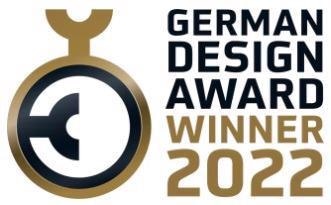
Image Credit: Carl Zeiss Microscopy GmbH
Highlights
One Interface for all ZEISS Microscopes in a Multi-user Environment

Image Credit: Carl Zeiss Microscopy GmbH
ZEN core provides an integrated user interface for ZEISS cameras and microscopes, ranging from entry-level stereo microscopes to completely automated imaging systems.
It allows the correlation of light and electron microscopy in multi-modal workflows, thereby offering connectivity among laboratories, systems and locations.
- Data acquisition and analysis
- Post-acquisition analysis
- Mobile Access
- Microscope and camera control
- Correlative microscopy
- Integrated reporting
- Interfaces for further analysis
- Automated segmentation
- Contextual analysis
- Central Data Management
- Connectivity between systems, laboratories and locations
User Management Designed to Assure Data Repeatability and Integrity
- Generate multiple user accounts with well-defined roles and privileges as per user requirement
- Make and control users’ accounts directly in ZEN core or connect to ActiveDirectory and repurpose those user accounts
- With ZEN Data storage as a principal hub for all the connected microscopes, manage all users successfully
- Leverage wide-ranging abilities and secure access with passwords to keep password guidelines and expiration period-appropriate.
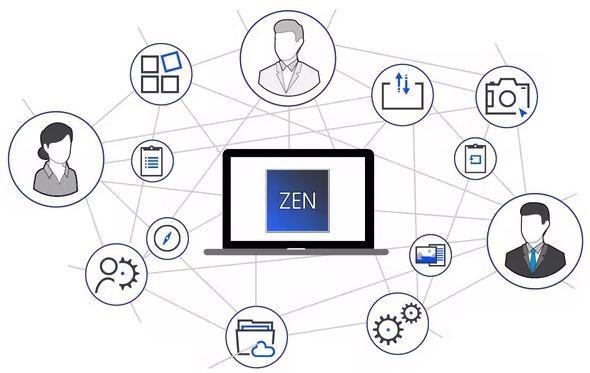
Image Credit: Carl Zeiss Microscopy GmbH
Perform Automated Segmentation, Contextual Analysis and Reporting
The desktop version of ZEN core is ZEN analyzer — made for activities that can be performed without a microscope. For post-processing tasks, the instrument is not blocked. Rather make use of it to perform other experiments — anytime, anywhere and with true efficiency.
- The best choice for analysis and segmentation, alongside reporting and making job templates
- Allows the user to utilize all workbenches accessible in ZEN core, offering complete control of all information and templates — which are accessible from the desk.
- Provides remote access to ZEN Data storage.

Image Credit: Carl Zeiss Microscopy GmbH
Materials Modules for Metallography Applications
ZEN core offers all significant metallographic applications within a central user interface — comprising material modules for the identification of phases, grain sizes and layer thicknesses, along with the classification of graphite particles and non-metallic inclusion analysis.
Cast Iron Analysis
Graphite particles in cast iron can take place in various distributions and shapes, based on parameters of the process and chemical composition of the material. This affects the material’s mechanical properties.
Completely automated analyses of the graphite particles’ shape and size are possible. Acquire the spheroid number as per EN ISO 945-1: 2008 + Cor.1:2010. Identify the nodularity of vermicular graphite and analyze the graphite particles’ content in area percentage.
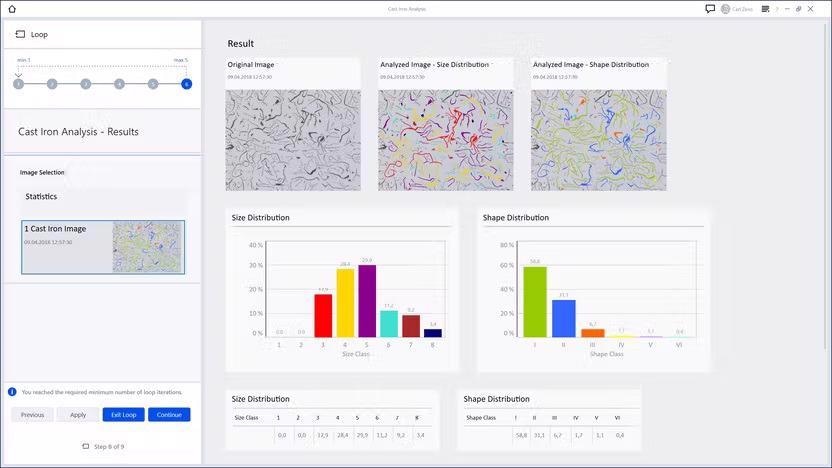
Cast Iron Analysis: Size and shape distribution. Image Credit: Carl Zeiss Microscopy GmbH
Grain Size Analysis
The distribution and size of grains are directly associated with the material properties. Measure the crystallographic structure of materialographic samples as per international standards. Three evaluation methods enable the user to define the material:
- Planimetric method for reconstruction of automatic grain boundary
- Comparison method for manual image examination with comparative diagrams
- Intercept method to interactively identify and quantify the intersections with grain boundaries using different chord patterns
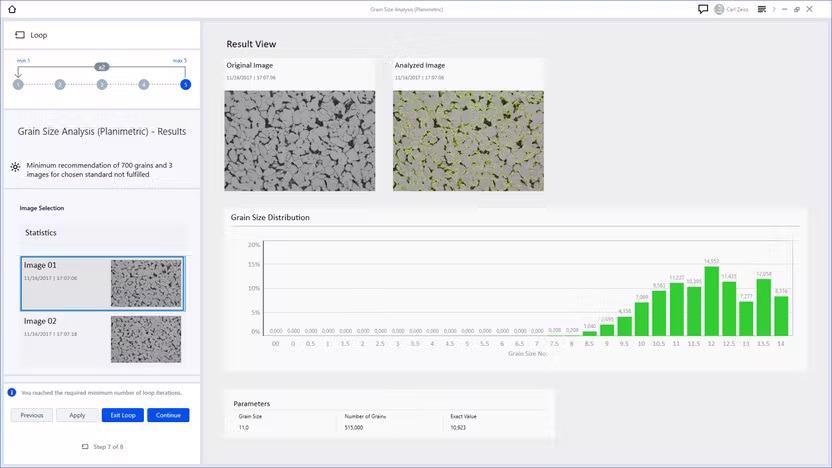
Grain Size Analysis: intercept method. Image Credit: Carl Zeiss Microscopy GmbH
Multiphase Analysis
Any material part with a unique crystal structure can be considered a “phase.” Various phases are isolated from each other by separate boundaries. Orientation and distribution of phases influence the material properties, such as strength, hardness or elongation at break.
The user can examine the phase distribution in his/her samples. Identify shape, size or orientation accurately and automatically. Utilize this distribution analysis to acquire data about additive manufactured material’s porosity.
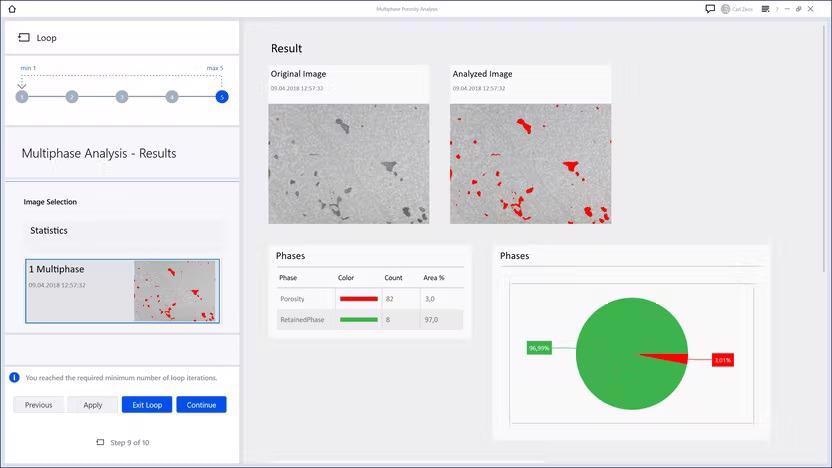
Multiphase Analysis: result view with distribution of different phases. Image Credit: Carl Zeiss Microscopy GmbH
Layer Thickness Measurement
Quantify the thickness of platings or coatings and the hardened surfaces’ depth in the sample’s cross-section.
Validate complex layers systems interactively or automatically. Based on the gradient available, the module measures the course of the measurement chords.
Achieve the results in a clear report comprising sample data, images and measurement values, like the maximum and minimum chord lengths, standard deviation and average.

Layer Thickness: automatic detection of a layer. Image Credit: Carl Zeiss Microscopy GmbH
Non-Metallic Inclusion Analysis (NMI)
NMI’s metallographic analysis is directed by industry standards that are backed by ZEN Core — guiding the user swiftly and effortlessly via the workflow, and creating a report and inclusion gallery that comply with the standards.
Potential inspection views and automatic deformation axis detection characteristics make analysis simple, repeatable and intuitive. ZEN core users can provide complete traceability and data integrity to their customers in NMI analyses, which implies that grade certification is auditable, specifically beneficial for users in regulated industries.
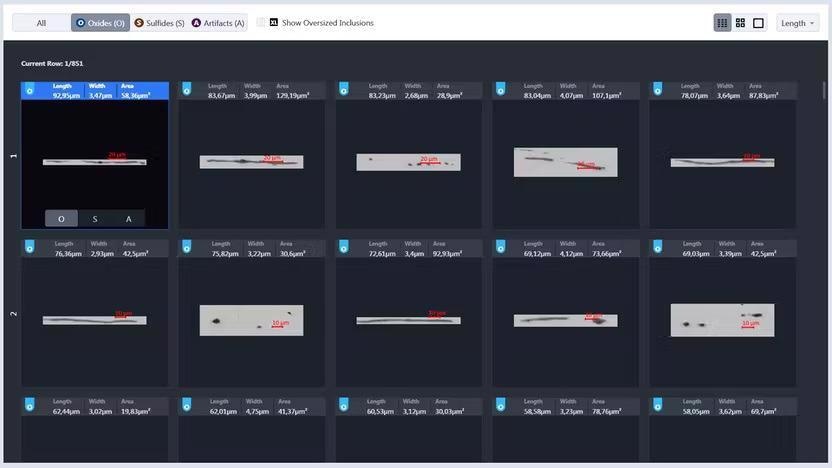
NMI: Global Results view providing the option to toggle between inclusion types: oxides, sulfides, and artifacts. Image Credit: Carl Zeiss Microscopy GmbH
Comparative Diagrams
Make Wall Charts digital. The user can compare the sample below the microscope using comparative diagrams on the screen directly.
The user can choose among various schematic micrographs with particular features. These change slowly from image to image and might relate to grain size, sample preparation sample or carbide precipitation in steel.
To design comparison diagrams, the module also offers a chart series creator, for example, pass/fail criteria in quality management or best target preparation images for individual material microstructures.
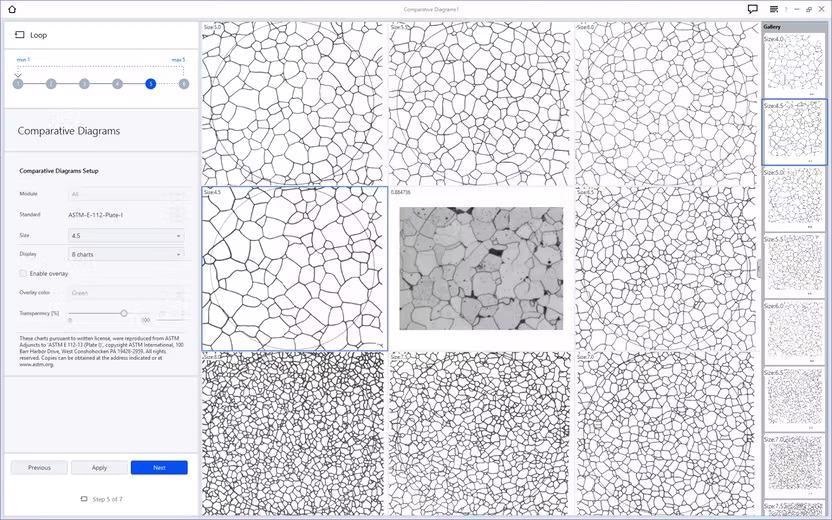
Comparative Diagrams: Compare the sample with standardized or customized wall charts. Image Credit: Carl Zeiss Microscopy GmbH
Advanced Imaging and Analysis
Automation for Light Microscopes
ZEN core offers an extensive range of options for automated image acquisition:
Enhanced Depth of Field
Get images automatically with improved depth of field.
Online Panorama
Get panorama images on coded and non-coded stages.
Free-Form Tiles
Effortlessly characterize stitching areas to make highly resolved images.
Linkam Stage Control
Witness materials under temperature.
Multi-Channel Acquisition
Get images in one go with multiple channels automatically — for example, multiple fluorescent channels or simply dark- and bright-field.
ZEN Intellesis Enables Image Segmentation by Machine Learning
Today’s microscopists’ biggest challenge is segmentation, but the user can prevent errors and user bias with the use of machine learning for the segmentation of the image.
ZEN Intellesis Segmentation
The software module offers potential machine learning segmentation of multidimensional images along with 3D datasets. It is developed for seamless integration of multiple imaging modalities and for attaining high-quality segmentation on any single image.
- Automatically analyze images that once had to be manually processed. The user can train a model to segment them.
- Users can utilize their expertise to train the software, making it perform the time-consuming segmentation, or import dedicated networks that are trained somewhere else (for example, on www.APEER.com).
- Take advantage of saving time in sample preparation, for the ZEN Intellesis Segmentation can be flexible to the preparation process. As the stored analysis program could be utilized again, sample by sample, or trained again to tackle new samples, reproducibility is assured.

(Left) Segmentation model training: The user labels a few regions just by painting them in to teach the system how to segment the image. (Right) Automated segmentation: Once a segmentation model has been trained, it can be re-used, shared, and applied to a bundle of images. Image Credit: Carl Zeiss Microscopy GmbH
ZEN Intellesis Object Classification
At times, segmenting objects like inclusions, particles or grains is simple. However, it could still be difficult to categorize them further into various types. Even machine learning-based segmentation methods may find it challenging in this scenario, as they only take the pixels’ appearance into consideration and cannot consider derived features of pixel clusters (objects).
Now, ZEN Intellesis Object Classification offers a simple method to categorize already segmented objects into subclasses. To do the categorization automatically, an object classification model can be trained.
- Rather than observing the individual pixels, the model employs more than 50 features quantified per object to classify them. Such derived measurements comprise intensity-based and geometric features.
- As ZEN Intellesis Object Classification functions on tabulated data and not on image data, the process of classification is much quicker than segmentation by dedicatedly trained deep neural networks.
- Additionally, the classification process is not dependent on the prior segmentation, regardless of whether it was performed by typical thresholding or with machine learning.
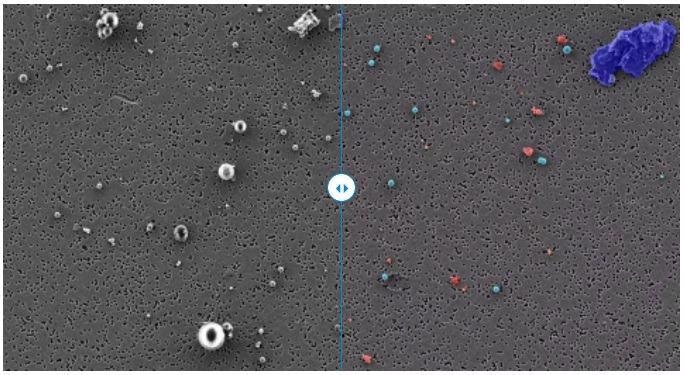
Object classification performed on standard nano- and microplastic particles (polystyrene (PS, light blue), polyethylene (PE, green), polyamide–nylon 6 (PA, dark blue), and polyvinyl chloride (PVC, red)) on a polycarbonate filter imaged with ZEISS Sigma. This correlative study combines the high resolution of an electron microscope with the analytical capabilities of a Raman microscope. The classification model is capable of distinguishing the different particle types based on their properties. Image Credit: Carl Zeiss Microscopy GmbH
Infrastructure Solutions for the Connected Laboratory
ZEN Connect: Quality Data Put in Context
Consolidate and observe various microscopy data and images in context, all in the same place, from the same sample. ZEN Connect workflows allow the user to achieve from a quick overview image to innovative imaging for sample-centric analysis with multiple modalities.
At different scales, the correlations among the images can be observed and seamlessly navigated. The different datasets’ interdependencies could be exported, stored and re-purposed in a Client-Server Database, ZEN Data Storage.
The user can perform exportable angle, line and area measurements within or across aligned images in the workspace. Across the connected images and datasets, it also allows integrated reporting.

ZEN Connect user interface: images at different scales can be easily navigated. Image Credit: Carl Zeiss Microscopy GmbH
Correlative Microscopy
Correlative microscopy — a potential method for integrating the corresponding attributes of various microscopic methods — achieves the utmost significant data from materials or parts samples.
ZEN Core — the ZEISS correlative microscopy interface — has been developed particularly for application in materials analysis that is available with motorized stages on all ZEISS light and electron microscopes.
- Relocate samples between LM and EM systems quicker than before
- Enhance throughput and efficiency
- Automatically transfer regions of interest
- Make well-informed material decisions
- Gather the most relevant information
ZEN Data Storage: Central Data Management in the Connected Laboratory
The user faces a constantly growing mass of images and information that requires management, predominantly in multi-user laboratories, as digitization continues to increase microscopic investigations.
ZEN Data Storage allows the user to isolate image and information acquisition from post-acquisition works, which makes everyone in the laboratory work more effectively in several ways:
- Share instrument presets, data, workflows and reports easily
- Analyses are reproducible and quality-assured
- Access all information from different locations and systems
- Assist IT departments in implementing backups and security
- Multi-modal workflows are able to achieve the maximum amount of data from the samples
- Integrate ZEN Data Explorer with ZEN Data Storage for achieving mobile access to data, letting the user use a tablet or smartphone to analyze the results while on the go.

Image Credit: Carl Zeiss Microscopy GmbH
GxP Module: Secure and Compliant Microscopy Processes
The GxP module allows traceable workflows via effortlessly combined microscopy hardware and software to fulfill the needs of regulated industries. All workflows available in ZEN core could be made to comply with GxP.
- Audit trail
- User management
- Electronic signatures, including countersign functionality
- Disaster recovery
- Release procedure of workflows
- Checksum protection of process-critical data
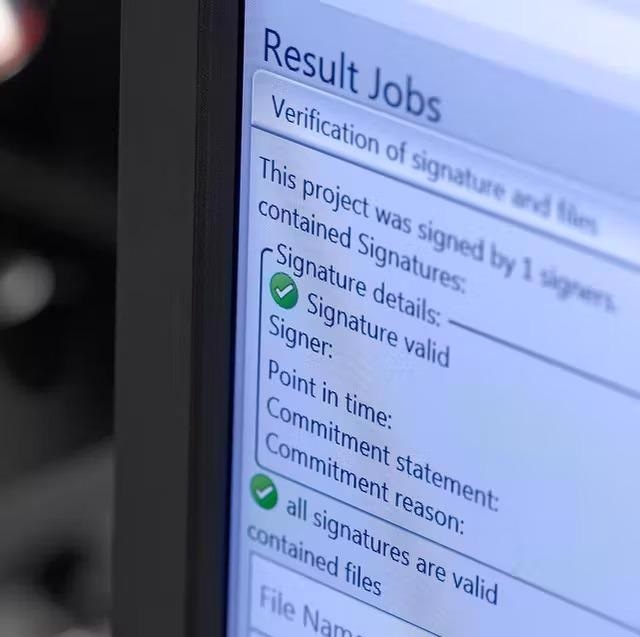
GxP module: Electronic signature validation. Image Credit: Carl Zeiss Microscopy GmbH
Module Packages
Source: Carl Zeiss Microscopy GmbH